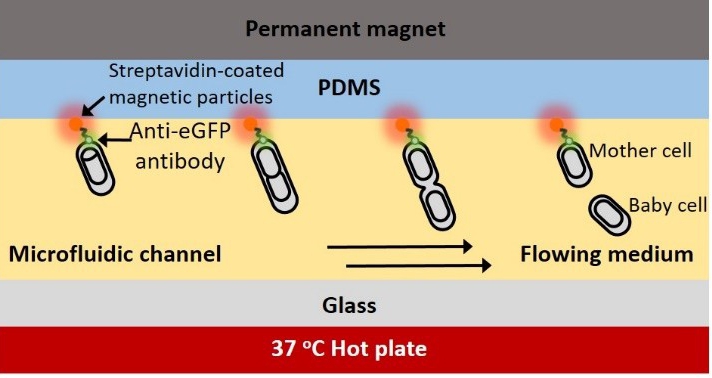A Novel Baby Machine Using Synthetic Magnetic Bacteria
The growth and division of bacteria are precisely regulated by a vital process known as the cell cycle. Just like the lifetime of a human being, a bacterial cell’s lifetime is composed of different events that occur at different stages of the cell cycle, with the size and physiology of the cell changing as the cycle proceeds. In normal bacterial culture, cells at different stages of the cell cycle are mixed together, so it is difficult to study separate events within the cycle. To gain insight into how the cell cycle regulates events in an orderly way, different methods have been developed to obtain synchronous cells.
Recently, a team led by Professor LIU Chenli at the Shenzhen Institutes of Advanced Technology (SIAT) of the Chinese Academy of Sciences created a novel microfluidic synchronizer using a synthetic magnetic bacterium to obtain populations of minimally-disturbed, normal, synchronized cells.
In their work, synthetic biology was applied to establish an artificial magnetic “stalk” at one pole of Escherichia coli. The inducible stalk was constructed from a chimeric fusion protein, eGFP-AIDAc that was heterologously expressed in the E. coli strain. This protein subsequently translocated to the cell poles, where it specifically bound to streptavidin-coated magnetic nanoparticles via biotinylated anti-eGFP antibodies. After one cell division, at most one cell pole retained a magnetic “stalk”.
One end of these synthetic magnetic bacteria can be attached to a microfluidic channel wall by using a permanent magnet. As these “mother” cells grow and divide in the flowing culture medium, “daughter” cells are born without the inducible, assembled “stalk”. They are hence not affected by the magnet and are eluted and collected (Fig.).

Fig. Magnetic bacteria in microfluidic channel
The construction of such a magnetic bacterium is not limited to E. coli strains. The inducible and modularized magnetic “stalk” can be easily assembled in a wide range of bacterial strains.
The microfluidic chip using in this study provides fine control of the micro-environment of cultured cells. Important features such as temperature, growth medium, and added chemical reagents can be adjusted easily. This novel microfluidic synchronizer significantly reduces the consumption of culture medium and increases the concentration of synchronous cells.
Synthetic biology is an interdisciplinary subject applying different disciplines, such as biotechnology, genetic engineering, biophysics, and computer science, to build artificial, modularized biological systems for useful purposes. In the research described here, a novel “baby machine” demonstrated that synthetic biology has great potential for applications in studies of bacterial physiology.
The study entitled " Microfluidic Synchronizer Using a Synthetic Nanoparticle-Capped Bacterium" was published in ACS Synthetic Biology.
CONTACT:
ZHANG Xiaomin
Email: xm.zhang@siat.ac.cn
Tel: 86-755-86585299
| Download the attachment: |
|
|